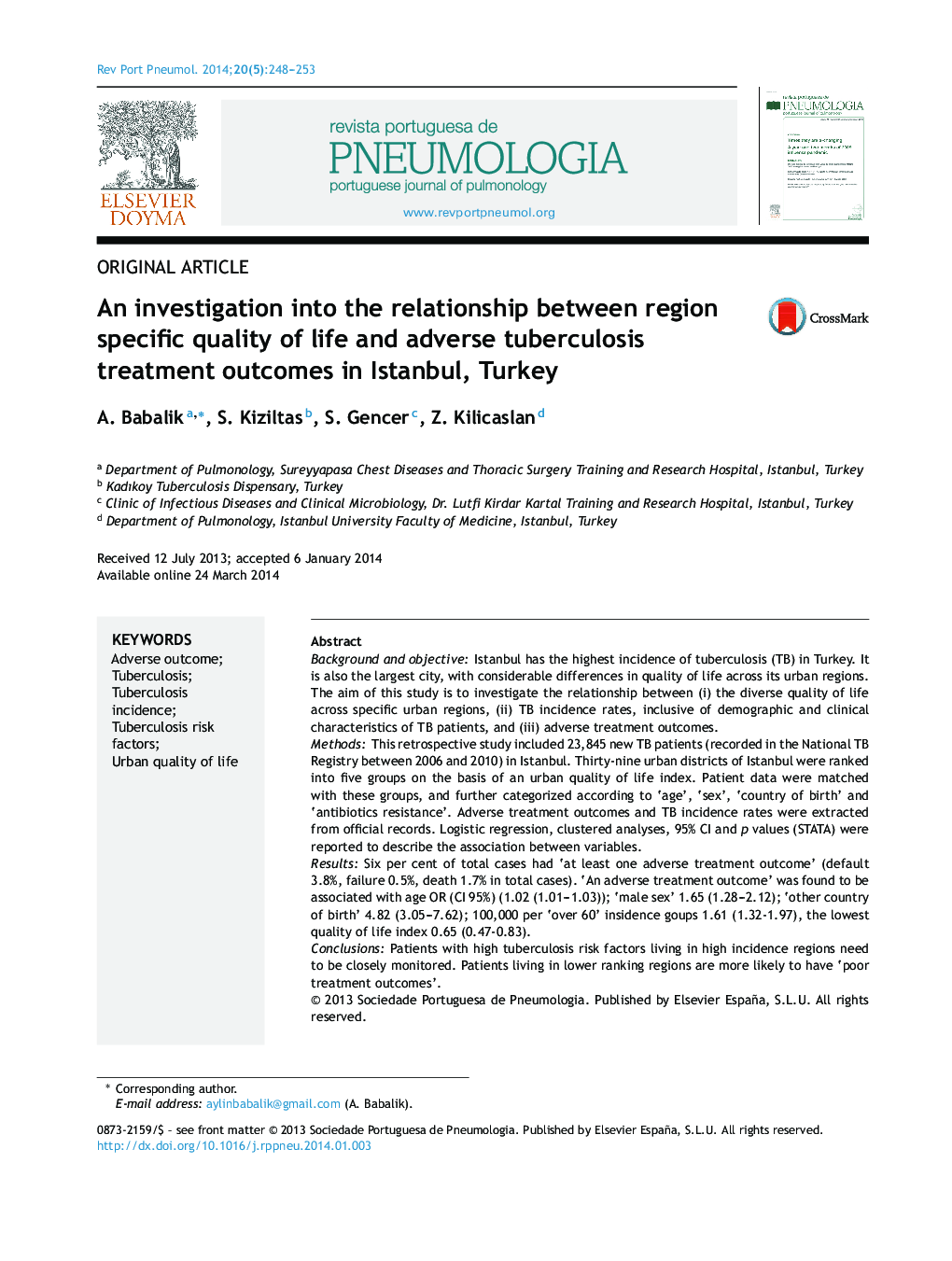| کد مقاله | کد نشریه | سال انتشار | مقاله انگلیسی | نسخه تمام متن |
|---|---|---|---|---|
| 4213723 | 1280934 | 2014 | 6 صفحه PDF | دانلود رایگان |
Background and objectiveIstanbul has the highest incidence of tuberculosis (TB) in Turkey. It is also the largest city, with considerable differences in quality of life across its urban regions. The aim of this study is to investigate the relationship between (i) the diverse quality of life across specific urban regions, (ii) TB incidence rates, inclusive of demographic and clinical characteristics of TB patients, and (iii) adverse treatment outcomes.MethodsThis retrospective study included 23,845 new TB patients (recorded in the National TB Registry between 2006 and 2010) in Istanbul. Thirty-nine urban districts of Istanbul were ranked into five groups on the basis of an urban quality of life index. Patient data were matched with these groups, and further categorized according to ‘age’, ‘sex’, ‘country of birth’ and ‘antibiotics resistance’. Adverse treatment outcomes and TB incidence rates were extracted from official records. Logistic regression, clustered analyses, 95% CI and p values (STATA) were reported to describe the association between variables.ResultsSix per cent of total cases had ‘at least one adverse treatment outcome’ (default 3.8%, failure 0.5%, death 1.7% in total cases). ‘An adverse treatment outcome’ was found to be associated with age OR (CI 95%) (1.02 (1.01–1.03)); ‘male sex’ 1.65 (1.28–2.12); ‘other country of birth’ 4.82 (3.05–7.62); 100,000 per ‘over 60’ insidence goups 1.61 (1.32-1.97), the lowest quality of life index 0.65 (0.47-0.83).ConclusionsPatients with high tuberculosis risk factors living in high incidence regions need to be closely monitored. Patients living in lower ranking regions are more likely to have ‘poor treatment outcomes’.
ResumoContexto e objetivoIstambul tem a mais elevada incidência de tuberculose (TB) na Turquia. É igualmente a sua maior cidade, com diferenças consideráveis na qualidade de vida ao longo das suas regiões urbanas. O objetivo deste estudo é investigar a relação entre i) as diversas qualidades de vida ao longo de regiões urbanas específicas, ii) taxas de incidência de TB, incluindo as características demográficas e clínicas dos doentes, e iii) resultados adversos do tratamento.MétodosEste estudo retrospetivo incluiu 23.845 novos doentes com TB (registados no Registo Nacional de TB, entre 2006-2010) em Istambul. Os trinta e nove distritos urbanos de Istambul foram classificados em 5 grupos com base no índice de qualidade de vida urbano. Os dados dos doentes foram correspondidos com estes grupos e subsequentemente divididos por categorias de acordo com a «idade», «sexo», «país de nascimento» e «resistência a antibióticos». Os resultados adversos ao tratamento e as taxas de incidência de TB foram retiradas dos registos oficiais. Regressão logística, análises agregadas, valores de CI e p de 95% (STATA) foram usados para descrever a associação entre variáveis.ResultadosSeis por cento do total de casos tiveram pelo menos um resultado adverso do tratamento (padrão 3,8%; insuficiência 0,5%; morte 1,7% do total de casos). «Um resultado adverso do tratamento» foi considerado como estando associado à idade (CI 95%) (1,02 [1,01-1,03]); «sexo masculino» 1,65 (1,28-2,12); «outro país de nascimento» 4,82 (3,05-7,62); 100.000 por grupos de incidência com «idade superior a 60 anos» 1,61 (1,32-1,97), o índice de qualidade de vida mais baixo 0,65 (0,47-0,83).ConclusõesOs doentes com altos fatores de risco de tuberculose em regiões de elevada incidência precisam de ser monitorizados de forma mais assídua. Os doentes que vivam em regiões de classificação inferior têm maior probabilidade de ter «maus resultados do tratamento».
Journal: Revista Portuguesa de Pneumologia - Volume 20, Issue 5, September–October 2014, Pages 248–253
